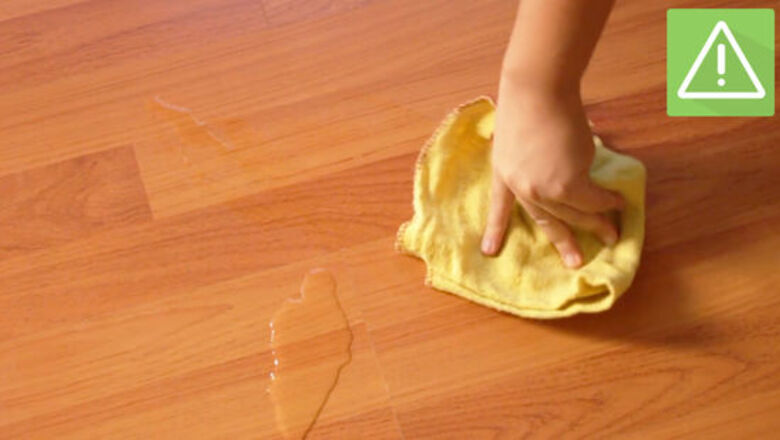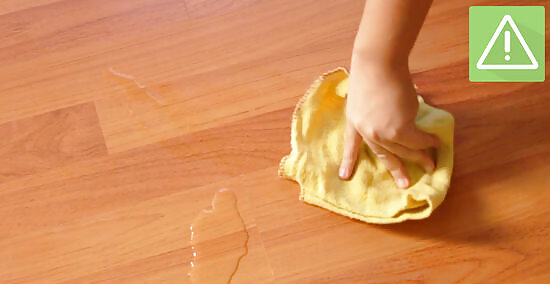
views
- Fill a bucket with hot water and use a mop to give your laminate flooring a deep clean. Be sure to dry the flooring with a cloth when you’re done.
- Spray a vinegar solution in small 1-foot (30.5 cm) squares and wipe the solution from the floor immediately with a damp terry or sponge mop.
- Stir 2 Tbsp (30 ml) of baby shampoo or mild detergent into a bucket of hot water. Then dip in and wring out a mop to wipe down your laminate flooring.
General Cleaning
Regularly sweep the floor. Sweep a dry dust mop across the surface of the floor every few days to remove everyday dirt. Even though laminate flooring is fairly scratch-resistant, excess dirt, hair, and debris can cause scratches to develop if allowed to build up over time. Regular sweeping prevents such scratches from forming. Instead of using a dry dust mop, you could also use a vacuum with a soft brush attachment. Do not use a standard floor brush. The stiff, straw-like bristles on the brush could damage the surface. Sweep in the direction that the laminate floor tiles were laid. Doing so allows you to pick up any debris that falls in between the grooves of the laminate flooring pieces.

Clean up spills immediately. Use a cloth or sponge to immediately clean up any liquid spills. Do not allow any liquid, even water, to sit on the floor for prolonged periods. Liquid can stain or damage the protective wear layer of the laminate flooring. Soak up excess liquid with a dry cloth. Dampen the cloth or sponge before spot-cleaning the location of the spill to remove any remaining residue. Dry the spot with a dry, soft cloth. Do not allow the area to remain wet.
Stick to a mop for deep cleaning, not a steam cleaner or buffer. Laminate isn't as strong as other flooring options, and it's easily damaged by devices like steam cleaners, buffers, and polishers. If your floor is looking dingy, use a mop and some elbow grease to clean it. It may take several passes to get the floor clean, but the mop is safer for your floors. If you can't get your floor clean no matter what you try, you can always call a professional.
Use vinegar or a mild detergent if you need more cleaning power. As another option, you can use a commercial product labeled for use on laminate flooring. Be sure to read the label and use the product correctly, as a little product goes a long way. Avoid using cleaners that promise to create a shiny surface, as these products can cause a waxy buildup on your floors. Similarly, don't use pine scented products on your laminate floors, as they may leave a dull, soapy residue.
Hot Water
Fill a bucket with hot water. The water does not need to be steaming hot, but it should be more than simply lukewarm. A thorough, wet wash should be performed every few months or after a wide area of the floor has gotten muddy or notably dirty. Hot water is often considered one of the best ways to clean laminate flooring because, when done correctly, it will not leave streaks. It is also the least likely to damage the protective coating of the laminate, since water is the mildest cleanser possible.
Soak and wring out a mop. Soak a sponge mop in the hot water and wring it out so that it is only mildly damp. You could use a traditional-style mop, but it is easier to control the saturation level of sponge mops. The mop should be wrung out well before using it. Even water can stain or warp the laminate floor if it is allowed to sit on the floor in puddles. That being the case, the mop should only be mildly damp before you use it on the laminate.
Give the flooring a thorough mopping. Cover the entire floor, starting from the center and working your way out. You could also work from one side of the room to the other. The only method you should avoid is working from the exterior of the room to the center, since you will need to walk across the newly-cleaned floor as it dries in order to leave the room. Since the mop is only barely damp, you may need to re-soak and re-wring it a few times during the cleaning process.
Dry the flooring. If the laminate is barely moist, you can let it air dry. Otherwise, wipe it dry with a clean, dry, microfiber cloth. Do not use an abrasive cloth, since this may scratch the flooring. Do not let puddles of water sit on the laminate for long periods of time.
Vinegar
Create a solution of vinegar and water. Pour 1/4 cup (60 ml) white vinegar into a 30 to 32 oz (940 to 1000 ml) spray bottle. Fill the rest of the bottle with plain water and shake well to combine. Diluted vinegar is especially useful when your laminate floor has caked on mud or other stains that have caused it to become faded or dull. Vinegar is too abrasive to be used in its pure form, so you must combine it with water. You could also create a similar vinegar-based solution by combining 1/3 cup (80 ml) vinegar with 3 squirts of liquid dish detergent and 1 gallon (4 liters) of warm water.
Spray the solution onto the laminate a little a time. Spray the vinegar onto the floor in areas no larger than small 1-foot (30.5 cm) squares. Do not spray the entire floor with the vinegar at once. You need to wipe the solution off the floor almost immediately, and spraying the entire floor at the same time will prevent you from cleaning off the vinegar before it starts to wear away at the protective coating of the laminate.
Wipe the solution up with a damp mop or cloth. Immediately after spraying the vinegar solution on the floor, wipe it off with a damp terry or sponge mop. You could also use a soft microfiber cloth. Do not use any mops or cloths that are abrasive, however. Make sure to wring out the mop or cloth before using it. Do not soak the floor with water, since letting moisture sit on it for too long could cause the floor to warp.
Dry the laminate. If a large amount of water has been left behind, soak it up and off the floor with a dry microfiber cloth. If only a small amount of water has been left behind, you may allow it to air dry without fearing damage to your laminate.
Gentle Soaps
Fill a bucket with hot water. Add roughly 1 gallon (4 liters) of warm to hot water to a large bucket. The water does not need to be steaming hot, but it should be significantly more than merely lukewarm.
Add a mild detergent or baby shampoo. Stir 2 Tbsp (30 ml) of baby shampoo or mild liquid dish detergent into the hot water. Do not use a scented or dyed dish detergent, since these are more likely to create streaks or cause damage to the laminate. Baby shampoo is gentle enough to use on laminate floors, but do not use standard adult shampoos. Mix the soap and water with your hand until the soap dissolves and bubbles begin to form. Do not use abrasive cleaners, like bleach or other strong cleaning chemicals.
Soak and wring out a mop. Soak a terry or sponge mop in the soapy solution. Wring it out thoroughly so that it is only mildly damp. Soapy water is a good choice when cleaning floors that have been exposed to mud, salt-covered snow boots, or other major forms of contamination. You could also use a microfiber cloth, but mops are preferable since you will be cleaning the entire floor at one time instead of working on small patches. Excess water can cause laminate flooring to become distorted. As a result, it is important that you wring out the mop until it is only mildly moist rather than soggy.
Wipe the floor from one side to the other. Start from one side of the room and work your way to the other side, covering the entire floor. You can also start in the center and work your way to the outside perimeter of the room. The only thing you should avoid doing is working your way from the outside into the center of the room, since you will have to cross over your newly cleaned floor to leave the room. Re-soak and re-wring the mop as necessary to make your way across the entire floor.
Dry the laminate. If you used a small amount of water, the flooring should air dry quickly. If it does not show any signs of air drying by the time you reach the other side of the room, dry it by hand using a dry microfiber cloth. Do not allow puddles of water to sit on the laminate for prolonged periods of time.
Removing Problem Stains
Clean blood stains with window cleaner. Spray a small amount of window cleaner on the stain and wipe it away immediately with a warm, mildly damp cloth. Use a non-abrasive microfiber cloth. The sooner you can attend to the stain, the easier it will be to remove it.
Remove chewing gum with a plastic knife. Scrape away the gum with a plastic knife and rub off any residue with a soft, damp cloth. Dampen the cloth with mineral spirits for best results. Do not use a metal knife, since it is too rough and more likely to scratch the floor.
Wipe away soda, wine, crayon marks, or ink with a damp cloth. These stains can usually be removed simply with a mildly damp microfiber cloth. You may need to apply mineral spirits to the cloth in order to remove waxy crayon marks. For stubborn ink stains, you may need to add a little detergent or ink remover to the cloth in order to completely remove the stain. Make sure to re-clean the area with a cloth soaked in warm, clean water afterward.
Get nail polish, shoe polish, or tar off with acetone nail polish remover. Add a little nail polish remover to a microfiber cloth and scrub the stain until it comes up. Wipe over the area with a microfiber cloth soaked in clean water afterward.
Erase heel marks and scuffs with a pencil eraser. Simply rub the eraser over these marks until they lift off the laminate.
Freeze away grease. Apply an ice pack or a package of frozen vegetables to the spot until the grease hardens. Scrape the frozen grease off using a plastic kitchen knife. Do not scrape the grease away with a metal utensil. Wipe off remaining grease residue by spraying a small amount of window cleaner on the spot and wiping it off with a damp cloth.




















Comments
0 comment